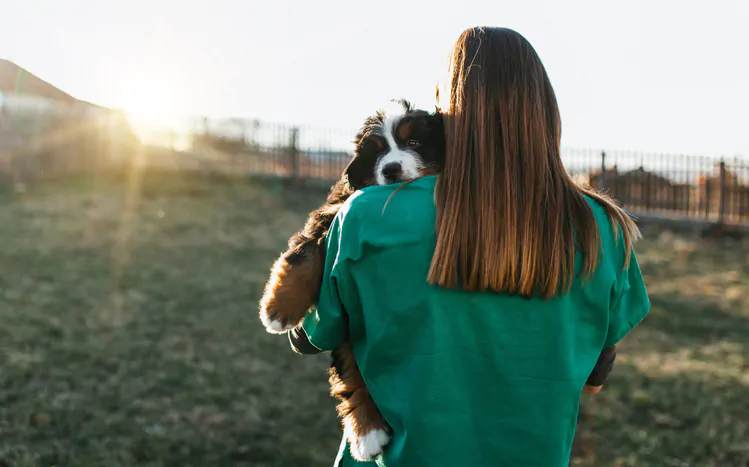
Safeguarding our furry friends this July

Nadeesha Fernando
10 July 2025
The thought of a pet going missing is a nightmare for any owner. Whether it’s an independent cat who doesn’t come home for dinner for days at a time, a dog that’s startled by a loud noise and makes a run for it, or the unthinkable scenario of a pet being stolen, it’s a horrible experience for both pet and owner.
The sad reality is that thousands of pets go missing in the UK every year. But by taking a few simple precautions, the likelihood of this happening can be significantly reduced.
- It’s national pet loss prevention nonth
- Beth’s story: the incredible rescue of Max
- Key tips for pet loss prevention
It’s national pet loss prevention month
July is a month of going on adventures in the sun, and if you have a dog, lots of dog walks. It also marks National Pet Loss Prevention Month, which is dedicated to raising awareness about preventing the heartbreak of a pet going missing.
The core purpose of National Pet Loss Prevention Month is to educate pet owners on the myriad ways to keep their pets safe. It’s about empowering us with the knowledge and tools to prevent those devastating moments of panic and uncertainty. This includes promoting a range of preventative measures, from high-tech solutions like GPS tracking to fundamental practices like secure fencing and always using a leash.
Beth’s story: the incredible rescue of Max
The heartbreak of a lost pet is a reality many owners face, and it’s a feeling our colleague Beth from Petgevity knows all too well. Her beloved family dog Max recently went missing, only to be reunited with Beth and her family thanks to an incredible network of volunteers, technology and pure determination. Max’s story serves as a powerful reminder of what can be achieved when communities come together, and why preparation is so crucial.
When Max bolted in a familiar area not far from home, his sudden disappearance left Beth and her family heartbroken. They immediately began searching and spreading the word. The following day local volunteers joined the search, scouring fields and woodland, putting up posters, and sharing social media alerts.
Two days into the search, after a number of possible sightings of Max, a lost dog social media group reached out to Dogateers – a volunteer-based pet recovery community – and Drone to Home – a dog drone searching charity – who kindly offered to help.
After three days there was still hope of bringing him home with more confirmed sightings. Dogateers volunteers attempted to deploy trail cameras and set a humane trap, but poor mobile signal in the area proved challenging. A thermal drone couldn’t fly due to bad weather. Beth and her family continued to leave out food, kept their door open in the hope Max would return, and tirelessly searched nearby fields with friends and neighbours who knew Max.
Four days into the search more sightings confirmed Max was still nearby, with the drone managing to find Max hiding deep in some undergrowth. With the drone monitoring, Beth’s mum was advised how best to approach Max, with Beth’s dad joining later with treats. Slowly, Max’s trust returned, and he came forward to be reunited with his loving family.
Max’s rescue was a testament to incredible teamwork and compassion of volunteers and members of the community who reported sightings and followed the crucial rule: don’t chase them or call out their name, especially if they’re fearful.
This heartwarming reunion highlights not only the power of community but also the importance of taking preventative measures. Both Dogateers and Drone to Home are volunteer-run, relying on donations for vital equipment. Supporting them helps bring more lost pets home.

Get your pet microchipped – it’s the law
One of the best things you can do is to get your pet microchipped. Not only is it a legal requirement for cats and dogs, but it could be the difference between you being reunited with a lost pet or not, as was the case for Max.
It’s tiny, and can be implanted without any pain to your pet. It’s essential not only to microchip your pet but also to keep your contact information updated with the microchip registry should your pet’s ownership change, or if you change your phone number or move house.
Get them a collar with an ID tag
There are other, more traditional things you can do to safeguard your pet – don’t underestimate the power of a good old-fashioned ID tag. A properly fitting collar with a clearly legible ID tag, that includes your name, address and phone number could result in your pet’s immediate return should someone find them. It’s a simple, cheap option that shouldn’t be overlooked.
Secure your yards and gardens
Preventative measures also extend to our homes. Making sure your house or flat and garden or yard are escape-proof is important. Check fences for loose boards, gates for dodgy locks or latches and be mindful of open doors or windows that could make for an easy getaway. Particularly for dogs, when you’re out in public, a lead is necessary. Even if your dog’s well-behaved, they can become unpredictable when faced with new sights, sounds, or scents. Even if you’re enjoying a walk without your dog on a lead, always take one with you in case the unexpected happens.
Be mindful of annual events (with fireworks)
It pays to be aware of national events that take place throughout the year, like Halloween (31 October), Bonfire Night (5 November) and New Year’s Eve. That’s because the sound of fireworks crackling throughout the day and night can cause pets to feel anxious – even those that are normally calm can panic and flee. Keeping pets indoors during fireworks, thunderstorms, or any other loud events is a wise safety measure. Creating a quiet space where they feel safe and secure is key.
GPS for your pet
It might also be worth considering a GPS tracker, which can offer an additional layer of security and protection, particularly for pets who tend to run off when left to explore the great outdoors. These devices allow you to monitor your pet’s location with great accuracy in real-time using your smartphone, providing an invaluable tool for recovery should they take off on an unsupervised adventure. Tractive offers smart GPS and health tracking for dogs and cats, and if you use the code DOGATEERS, you can get 40% off the normal price.

Key tips for pet loss prevention
Max was lucky, but not all missing pets are found. Let’s recap some of the best ways to keep your pets safe and sound, and solutions on how to be reunited with them should they go missing.
- Microchip your pets and keep the information updated
- Use secure collars with ID tags that include your contact information
- Ensure your home and outside spaces are escape-proof
- Take a lead with you at all times in public spaces
- Keep pets indoors during fireworks, storms or other loud events
- Consider fitting them with a GPS tracker
National Pet Loss Prevention Month reminds us that our pets depend on us for their safety and well-being. Your pet’s safety is in your hands – let’s protect them together.


